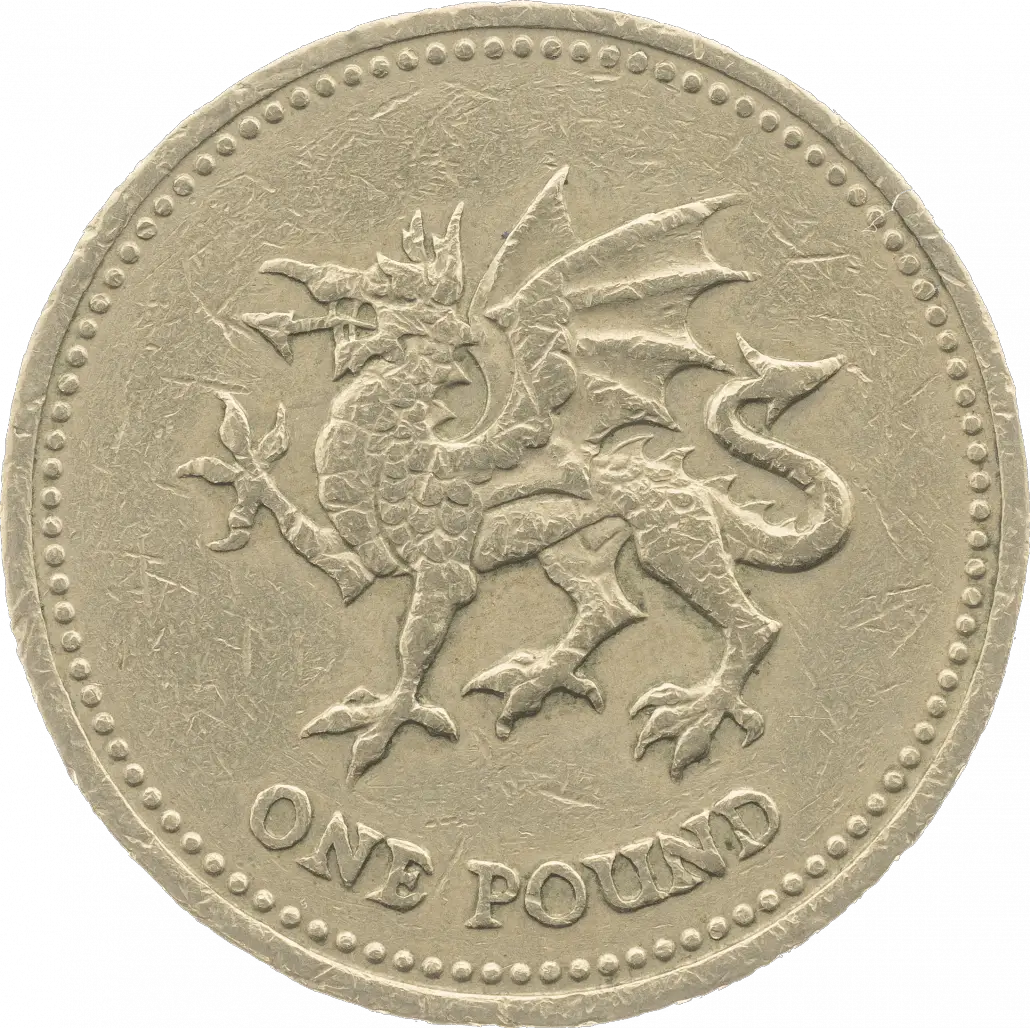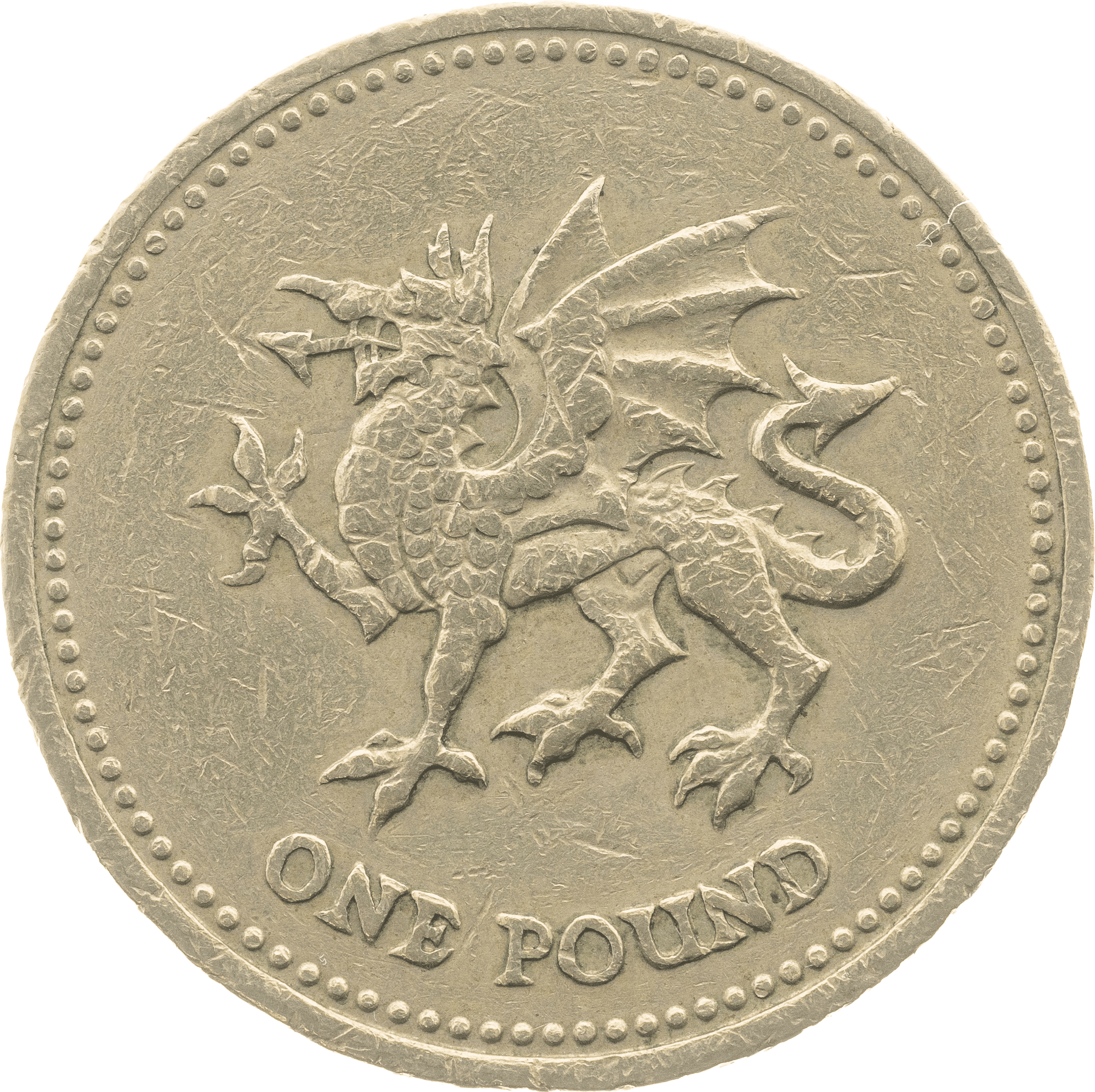Complete your heraldic emblem collection with this Dragon £1 coin. It is the second issue of a four-part series of coins designed to represent Wales as one of the four constituent countries of the United Kingdom.
What makes this dragon coin a must-have for collectors?
How Much Are The Dragon £1 Coins Worth?
A specific Dragon £1 Coin worth is somewhat determined by which year the coin was minted and how many were issued to determine its rarity.
The Dragon £1 coin was issued in 1995 and again in 2000.
- The 1995 version minted 34,503,501
- The 2000 version minted 109,496,500 which is more than three times as many minted as the 1995 issue
The design was reissued as part of a 14-coin commemorative set marking the 25th anniversary of the £1 coin in 2008 as a collector coin in both gold and silver.
It was also issued in 2016 as a twenty-pound silver coin.
Expect to find the dragon round pound coins selling for a price as follows according to past sold values on eBay:
- 1995 Dragon £1 = estimated value of £2.44
- 2000 Dragon £1 = estimated value of £2.71
We found it quite interesting that the 2000 version had a slightly higher average selling price, despite having a much larger mintage.
Design Of The Dragon £1 Coin

The coin is part of the £1 round coins that were issued each year with a special reverse design to represent an emblem of the UK, Scotland, Wales, Northern Ireland, or England. The reverse was changed each year from1983 to 2008 to reflect a design that represented the United Kingdom, Scotland, Wales, Northern Ireland, and England.
The Dragon £1 coin was designed to represent Wales.
The Dragon £1 coin designs were part of a 4-part series representing the four constituent countries of the UK using heraldic emblems. This series started in 1994 with the Lion Rampant representing Scotland. In 1995, the coin represented Wales with a Dragon design. In 1996, a Celtic Cross and Torc represented Northern Ireland. In 1997, Three Lions represented England.
This 4-part series of heraldic emblems on the reverse side of the round pound would repeat starting again in 1999 through 2002 with the same reverse image designs.
Both of the Dragon coins were part of the round £1 coins. The British £1 coin is a denomination of the pound sterling. The original £1 coin replaced the Bank of England £1 note that was no longer issued after 1984 but was not removed from circulation until March 11, 1988. The coin is made in Nickel-brass.
After 2017, the older £1 coins could only be redeemed at banks. For a limited time, some retailers would also accept them. Although, they remained in use in the Isle of Man.
The edge of the coin is milled with an inscription and a small crosslet as a mint mark that represents Llantrisant in South Wales where the Royal Mint has been based since 1968. The milled edge with an inscription was used in an attempt to protect them from debasement by clipping or shaving off the edge of gold coins for the purpose of melting it down to sell or make counterfeit coins.
The edge of the £1 dragon coin is a milled edge that includes the inscription that reads PLEIDIOL WYF I’M GWLAD. Translated, this means “True am I to my country.” The phrase was part of the Welsh National Anthem.
The 1995 and 2000 versions of the coin represent Wales featuring a dragon on the reverse side. This image depicts the strength, fire and spirit of the Welsh national character.
The image on the coin is a Dragon Passant which is found on the country’s national flag. It is a version of the red dragon Cadwaladr, which is the badge attributed to the King of Gwynedd in the 7th century. Passant refers to the position the dragon is in with one foot raised referring to the walking position.
The dragon is facing left in the passant position. The words ONE POUND are centred beneath the dragon’s feet. Raised beaded dots encircle the image around the outer rim.
Wales was first represented on the£1 round coin in 1985 and 1990 with the same leek floral emblem design on both issues. This time Wales would be represented with a different design on the 1995 and 2000 Dragon passant coin.
In 2005 Wales was again represented on the Menai Straits Bridge coin and again in 2011 with the Coat of arms of Cardiff. In 2013, the original leek emblem made its appearance once again on the Leek and Daffodil £1 coin.
Wales has not been represented on the round pound coin since the £1 coin changed to be a 12-sided, bi-metallic coin in 2017.
The Dragon £1 coin is 22.50 millimetres in diameter and weighs 9.50 grams in Nickel-brass alloy with a thickness of 3.15 mm. The £1 Round series of coins were the only UK coin to display a distinct yellow colour.
1995 Obverse
The obverse of the 1995 Dragon coin features the portrait of Queen Elizabeth II that Raphael Maklouf designed. In the image, the Queen wears the George IV State Diadem, officially the Diamond Diadem. The crown pictured was made in 1820 for King George IV. There is an inscription surrounding her portrait that reads ELIZABETH II D.G. REG.F.D. followed by the minting year 1995. The inscription translates to mean Elizabeth II Dei Gratia Regina, by the grace of God, Queen, Defender of the Faith.
Look for the designer’s initials of RDM in the bottom left-hand corner of the Queen’s portrait.
2000 Obverse
The obverse of the 2000 Dragon coin is the design of Ian Rank-Broadley. Ian Rank-Broadley was more of a realist than the previous designer. Rank-Broadley was not afraid to reveal the queen as looking more mature than she did in the previous image. He also made the image much larger than previous designs.
He depicted Her Majesty wearing the “Girls of Great Britain and Ireland” diamond tiara. The tiara in the image was a 1947 wedding gift from Queen Mary, her grandmother.
The inscription surrounding her portrait reads ELIZABETH II D.G. REG.F.D. followed by the minting year of 2000. Translated, the inscription means Elizabeth II Dei Gratia Regina, by the grace of God, Queen, Defender of the Faith.
The designer’s initials IRB are seen directly under the neckline of the Queen’s portrait.
What Does The Coin Represent?
The design on both the 1995 and the 2000 Dragon coin represents Wales with an image of a dragon. Wales is one of the four parts of the United Kingdom.
The dragon is an iconic symbol seen often on Welsh flags flown to celebrate St. David’s Day or at sporting events. The dragon, sometimes called the Y Ddraig Goch, symbolizes power and authority. The dragon is named Dewi which is Welsh for David, named after the patron saint of Wales.
The image of the dragon has been used in Wales since the reign of Cadwaladr, King of Gwynedd from about 655 AD. But, its meaning may go back even before this.
The dragon symbol was largely popularized by the Romans who used to fix bronze and silk dragons to their lances during battle. The words dragon or dreic appeared in Welsh texts as early as the 6th Century.
In the 12th Century, the legend of Merlin and two sleeping dragons was spread.
There was such fascination with the mythical creatures that when one ruler attacked Caernarfon Castle in 1401, he apparently flew a flag depicting a golden dragon.
Later, a white dragon was used to represent the Anglo-Saxons and a yellow dragon on a red background to represent the kingdom of Wessex. The red dragon often reigned supreme with many Welsh poets writing about it.
Starting in the 15th Century, Henry Tudor, Henry VII, used the image of a dragon during the Battle of Bosworth in 1485 to prove he was a descendant of Cadwaladr, King of Gwynedd, the last of the Briton Kings whose banner was originally the red dragon.
After the union of parliaments of Great Britain and Ireland, in 1807, the red dragon was adopted as an emblem for Wales. The design using a dragon was used to form the first official Welsh flag created for the Queen’s coronation in 1953.
In 1959 the flag of Wales was changed to reflect the current dragon image design.
Dragon Coin Designer
Norman Sillman designed the Dragon coin that would represent Wales as one of the parts of the United Kingdom. His design for the Dragon coin was chosen from a drawing provided by the College of Arms.
Sillman was a British sculptor and a coin designer. He was a sculptor in London until 1956, spending a lot of time drawing images of animals from the London Zoo that he would later sculpt.
In 1956, The Royal Mint commissioned Sillman to design a coin for Bermuda. He also designed coins for the Birmingham Mint, York Mint, Metalimport, Sandhill Ltd, Danbury Mint USA, Franklin mint USA, and others. He ultimately designed coins for at least 30 countries. He also designed several medals for Britain.
For Britain, he designed the Scottish Commonwealth Games £2 Coin and this heraldic-emblem four-part series for the £1 coin.
Where Can You Buy The Dragon Coin?
Look for dragon £1 coins on eBay as a quick and easy way to find coins. Just make sure to do a little research first, so you know what to look for whenever buying or selling online.
You can also browse the Royal Mint’s shop if you are interested in purchasing uncirculated coins.
